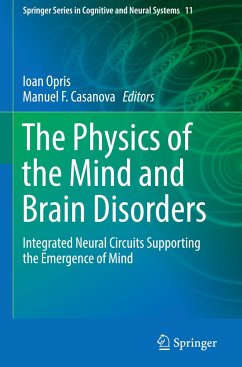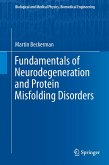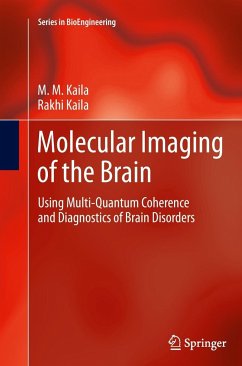The Physics of the Mind and Brain Disorders
Integrated Neural Circuits Supporting the Emergence of Mind
Herausgegeben:Opris, Ioan; Casanova, Manuel F.
The Physics of the Mind and Brain Disorders
Integrated Neural Circuits Supporting the Emergence of Mind
Herausgegeben:Opris, Ioan; Casanova, Manuel F.
- Gebundenes Buch
- Merkliste
- Auf die Merkliste
- Bewerten Bewerten
- Teilen
- Produkt teilen
- Produkterinnerung
- Produkterinnerung
This book covers recent advances in the understanding of brain structure, function and disorders based on the fundamental principles of physics. It covers a broad range of physical phenomena occurring in the brain circuits for perception, cognition, emotion and action, representing the building blocks of the mind. It provides novel insights into the devastating brain disorders of the mind such as schizophrenia, dementia, autism, aging or addictions, as well as into the new devices for brain repair. The book is aimed at basic researchers in the fields of neuroscience, physics, biophysics and…mehr
Andere Kunden interessierten sich auch für
![Fundamentals of Neurodegeneration and Protein Misfolding Disorders Fundamentals of Neurodegeneration and Protein Misfolding Disorders]() Martin BeckermanFundamentals of Neurodegeneration and Protein Misfolding Disorders81,99 €
Martin BeckermanFundamentals of Neurodegeneration and Protein Misfolding Disorders81,99 €![Arterial Stiffness Arterial Stiffness]() Bradley S. FleenorArterial Stiffness41,99 €
Bradley S. FleenorArterial Stiffness41,99 €![microRNA: Basic Science microRNA: Basic Science]() microRNA: Basic Science81,99 €
microRNA: Basic Science81,99 €![Introduction to Biomolecular Structure and Biophysics Introduction to Biomolecular Structure and Biophysics]() Introduction to Biomolecular Structure and Biophysics121,99 €
Introduction to Biomolecular Structure and Biophysics121,99 €![High Pressure Bioscience High Pressure Bioscience]() High Pressure Bioscience168,99 €
High Pressure Bioscience168,99 €![Dendritic Cells: Biophysics, Tumor Microenvironment and Chinese Traditional Medicine Dendritic Cells: Biophysics, Tumor Microenvironment and Chinese Traditional Medicine]() Zhu ZengDendritic Cells: Biophysics, Tumor Microenvironment and Chinese Traditional Medicine41,99 €
Zhu ZengDendritic Cells: Biophysics, Tumor Microenvironment and Chinese Traditional Medicine41,99 €![Molecular Imaging of the Brain Molecular Imaging of the Brain]() M. M. KailaMolecular Imaging of the Brain121,99 €
M. M. KailaMolecular Imaging of the Brain121,99 €-
-
-
This book covers recent advances in the understanding of brain structure, function and disorders based on the fundamental principles of physics. It covers a broad range of physical phenomena occurring in the brain circuits for perception, cognition, emotion and action, representing the building blocks of the mind. It provides novel insights into the devastating brain disorders of the mind such as schizophrenia, dementia, autism, aging or addictions, as well as into the new devices for brain repair. The book is aimed at basic researchers in the fields of neuroscience, physics, biophysics and clinicians in the fields of neurology, neurosurgery, psychology, psychiatry.
Produktdetails
- Produktdetails
- Springer Series in Cognitive and Neural Systems 11
- Verlag: Springer / Springer International Publishing / Springer, Berlin
- Artikelnr. des Verlages: 978-3-319-29672-2
- 1st ed. 2017
- Seitenzahl: 812
- Erscheinungstermin: 15. Dezember 2017
- Englisch
- Abmessung: 241mm x 160mm x 46mm
- Gewicht: 1478g
- ISBN-13: 9783319296722
- ISBN-10: 3319296728
- Artikelnr.: 44392826
- Herstellerkennzeichnung Die Herstellerinformationen sind derzeit nicht verfügbar.
- Springer Series in Cognitive and Neural Systems 11
- Verlag: Springer / Springer International Publishing / Springer, Berlin
- Artikelnr. des Verlages: 978-3-319-29672-2
- 1st ed. 2017
- Seitenzahl: 812
- Erscheinungstermin: 15. Dezember 2017
- Englisch
- Abmessung: 241mm x 160mm x 46mm
- Gewicht: 1478g
- ISBN-13: 9783319296722
- ISBN-10: 3319296728
- Artikelnr.: 44392826
- Herstellerkennzeichnung Die Herstellerinformationen sind derzeit nicht verfügbar.
Preface.- PART 0.-Chapter 1. What Makes the Human Brain Special: Key Features of Brain and Neocortex (J. H. Kaas, Suzana Herculano-Houzel) .- Chapter 2. Introduction: From Neurons to the Mind (A. I. Popescu, I. Opris).- PART I.- Chapter 3. Systems Theory, Emergent Properties, and the Organization of the Central Nervous System .- (M. F. Casanova, I. Opris, E. Sokhadze, E. L. Casanova).- Chapter 4. Integrated Neural Circuits Supporting the Emergence of Mind (I. Opris, M. F. Casanova, M. A. Lebedev, A. I. Popescu).- Chapter 5. The Hierarchical Circuit for Executive Control of Movement (I. Opris and B. R. Noga).- Chapter 6. Symmetry and Noether Theorem for Brain Microcircuits (L. Bilteanu, M. F. Casanova, I. Opris).- Chapter 7. Locomotion and Symmetry Breaking in the Brain (B. R. Noga, I. Opris).- Chapter 8. Perturbation of Symmetry Breaking in Cognitive Disorders (I. Opris, B. R. Noga, M. F. Casanova).- Chapter 9. Gauge Fields in the Central Nervous System (A. Tozzi, B. Sengupta, J. F. Peters, K. Friston).- Chapter 10. Brain and Nonlinear Dynamics: Slow-wave Sleep Regulates to the Edge of Chaos (D. A. Steyn-Ross and Moira L. Steyn-Ross).- Chapter 11. Slow Oscillation in Prefrontal Cortex Underlying Local Computations and Large-Scale Interactions (S. Fujisawa) .- Chapter 12. Memory as Integration and Selection Processes over Space and Time in Temporal Cortical Microcircuits (M. Takeda).- Chapter 13. Holographic Memory: a Novel Model of Information Processing by Neuronal Microcircuits (A. Redozubov).- Chapter 14. Factors Influencing Opposing Effects of Emotion on Cognition: A Review of Evidence from Research on Perception and Memory (F. Dolcos, Y. Katsumi, E. Denkova, S. Dolcos).- PART II.- Chapter 15. Neural Correlates of Normal and Impaired Consciousness (A. Cavanna).- Chapter 16. EEG assessment of Consciousness Rebooting from Coma (C-A. erban, A. Barborica, A-M. Roceanu, I-R. Mîndru a, J. Ciurea, A-M. Zagrean, L. Zagrean and M. Moldovan).- Chapter 17. Role of Feed-Forward Inhibition in Neocortical Information Processing: Implications for Neurological Disorders (O. V. Favorov, O. Kursun, M. Tommerdhal).- Chapter 18. Cortical Microstructures: Lateralization, Ageing and Disruption across the Lifespan S. A. Chance.- Chapter 19. Building Elements of the Adaptive and Pathological Pain Neural Networks Maria-Luiza Flonta.- Chapter 20. Connectomics in Patients with Temporal Lobe Epilepsy (C. Donos, A. Barborica, I-R. Mîndruta, M. Maliia, I. Popa, J. Ciurea).- PART III.- Chapter 21. Grid cells-From Data Acquisition to Hardware Implementation: a Model for Connectome-Oriented Neuroscience (D. Deca).- Chapter 22. Multipotentiality of the Brain to be Revisited Repeatedly (Y. Sakurai, T. Ohnuki, R. Shiroshita, Y. Sakaguchi, K. Shiotani, and C. Jung Lee).- Chapter 23. Characterization of Complex Brain Functions with Sparse Nonlinear Dynamical Modeling (D. Song and T. Berger).- Chapter 24. Controlling Attention with Neurofeedback (M. Ordikhani-Seyedlar, M. A. Lebedev).- Chapter 25. Towards a Visual Story Network Using Multiple Views for Object Recognition at Different Levels of Spatiotemporal Context (M. Leordeanu, R. Sukthankar).- PART IV.- Chapter 26. Pharmacology of the Mind (J. Tsou).- Chapter 27. Genetics of the Mind and Brain Disorders (T. Popovitchenko and M.-R. Rasin.- Chapter 28. The Spiritual Brain: Science and Religious Experience (A. Newberg).- Chapter 29. The Neurobiology of Moral Decision-Making, Embodied Cognition and the Case of Tolerance (Diana Stanciu).- Chapter 30. Insights into the Animal's Mind (G. Predoi, I. Raus, F. Barbuceanu, I. Opris ).- PART V.- Chapter 31. Blood Brain Barrier and the Mind (Ana-Maria Zagrean, B. Ianosi, C. Sonea, I. Opris, L. Zagrean).- Chapter 32. Application of a Conceptual Nanomedical Vascular Cartographic Scanning Nano-Device (VCSN) to the Mapping of the Human Brain: Survey of Human Brain Function and Cognitive Implications (Angela Domschke and F. Bohm).-Chapter 33. A Unified Physical Theory for CSF Circulation, Cooling and Cleaning of the Brain, Sleep, and Head Injuries in Degenerative Cognitive Disorders (I. Cherian and Margarita Beltran).- Chapter 34. Mind the Reward: Nutrition vs. Addiction (C. Sonea, A. L. Opris, M. F. Casanova, M. V. Constantinescu, I. Opris). Index.
Preface.- PART 0.-Chapter 1. What Makes the Human Brain Special: Key Features of Brain and Neocortex (J. H. Kaas, Suzana Herculano-Houzel) .- Chapter 2. Introduction: From Neurons to the Mind (A. I. Popescu, I. Opris).- PART I.- Chapter 3. Systems Theory, Emergent Properties, and the Organization of the Central Nervous System .- (M. F. Casanova, I. Opris, E. Sokhadze, E. L. Casanova).- Chapter 4. Integrated Neural Circuits Supporting the Emergence of Mind (I. Opris, M. F. Casanova, M. A. Lebedev, A. I. Popescu).- Chapter 5. The Hierarchical Circuit for Executive Control of Movement (I. Opris and B. R. Noga).- Chapter 6. Symmetry and Noether Theorem for Brain Microcircuits (L. Bilteanu, M. F. Casanova, I. Opris).- Chapter 7. Locomotion and Symmetry Breaking in the Brain (B. R. Noga, I. Opris).- Chapter 8. Perturbation of Symmetry Breaking in Cognitive Disorders (I. Opris, B. R. Noga, M. F. Casanova).- Chapter 9. Gauge Fields in the Central Nervous System (A. Tozzi, B. Sengupta, J. F. Peters, K. Friston).- Chapter 10. Brain and Nonlinear Dynamics: Slow-wave Sleep Regulates to the Edge of Chaos (D. A. Steyn-Ross and Moira L. Steyn-Ross).- Chapter 11. Slow Oscillation in Prefrontal Cortex Underlying Local Computations and Large-Scale Interactions (S. Fujisawa) .- Chapter 12. Memory as Integration and Selection Processes over Space and Time in Temporal Cortical Microcircuits (M. Takeda).- Chapter 13. Holographic Memory: a Novel Model of Information Processing by Neuronal Microcircuits (A. Redozubov).- Chapter 14. Factors Influencing Opposing Effects of Emotion on Cognition: A Review of Evidence from Research on Perception and Memory (F. Dolcos, Y. Katsumi, E. Denkova, S. Dolcos).- PART II.- Chapter 15. Neural Correlates of Normal and Impaired Consciousness (A. Cavanna).- Chapter 16. EEG assessment of Consciousness Rebooting from Coma (C-A. erban, A. Barborica, A-M. Roceanu, I-R. Mîndru a, J. Ciurea, A-M. Zagrean, L. Zagrean and M. Moldovan).- Chapter 17. Role of Feed-Forward Inhibition in Neocortical Information Processing: Implications for Neurological Disorders (O. V. Favorov, O. Kursun, M. Tommerdhal).- Chapter 18. Cortical Microstructures: Lateralization, Ageing and Disruption across the Lifespan S. A. Chance.- Chapter 19. Building Elements of the Adaptive and Pathological Pain Neural Networks Maria-Luiza Flonta.- Chapter 20. Connectomics in Patients with Temporal Lobe Epilepsy (C. Donos, A. Barborica, I-R. Mîndruta, M. Maliia, I. Popa, J. Ciurea).- PART III.- Chapter 21. Grid cells-From Data Acquisition to Hardware Implementation: a Model for Connectome-Oriented Neuroscience (D. Deca).- Chapter 22. Multipotentiality of the Brain to be Revisited Repeatedly (Y. Sakurai, T. Ohnuki, R. Shiroshita, Y. Sakaguchi, K. Shiotani, and C. Jung Lee).- Chapter 23. Characterization of Complex Brain Functions with Sparse Nonlinear Dynamical Modeling (D. Song and T. Berger).- Chapter 24. Controlling Attention with Neurofeedback (M. Ordikhani-Seyedlar, M. A. Lebedev).- Chapter 25. Towards a Visual Story Network Using Multiple Views for Object Recognition at Different Levels of Spatiotemporal Context (M. Leordeanu, R. Sukthankar).- PART IV.- Chapter 26. Pharmacology of the Mind (J. Tsou).- Chapter 27. Genetics of the Mind and Brain Disorders (T. Popovitchenko and M.-R. Rasin.- Chapter 28. The Spiritual Brain: Science and Religious Experience (A. Newberg).- Chapter 29. The Neurobiology of Moral Decision-Making, Embodied Cognition and the Case of Tolerance (Diana Stanciu).- Chapter 30. Insights into the Animal's Mind (G. Predoi, I. Raus, F. Barbuceanu, I. Opris ).- PART V.- Chapter 31. Blood Brain Barrier and the Mind (Ana-Maria Zagrean, B. Ianosi, C. Sonea, I. Opris, L. Zagrean).- Chapter 32. Application of a Conceptual Nanomedical Vascular Cartographic Scanning Nano-Device (VCSN) to the Mapping of the Human Brain: Survey of Human Brain Function and Cognitive Implications (Angela Domschke and F. Bohm).-Chapter 33. A Unified Physical Theory for CSF Circulation, Cooling and Cleaning of the Brain, Sleep, and Head Injuries in Degenerative Cognitive Disorders (I. Cherian and Margarita Beltran).- Chapter 34. Mind the Reward: Nutrition vs. Addiction (C. Sonea, A. L. Opris, M. F. Casanova, M. V. Constantinescu, I. Opris). Index.








